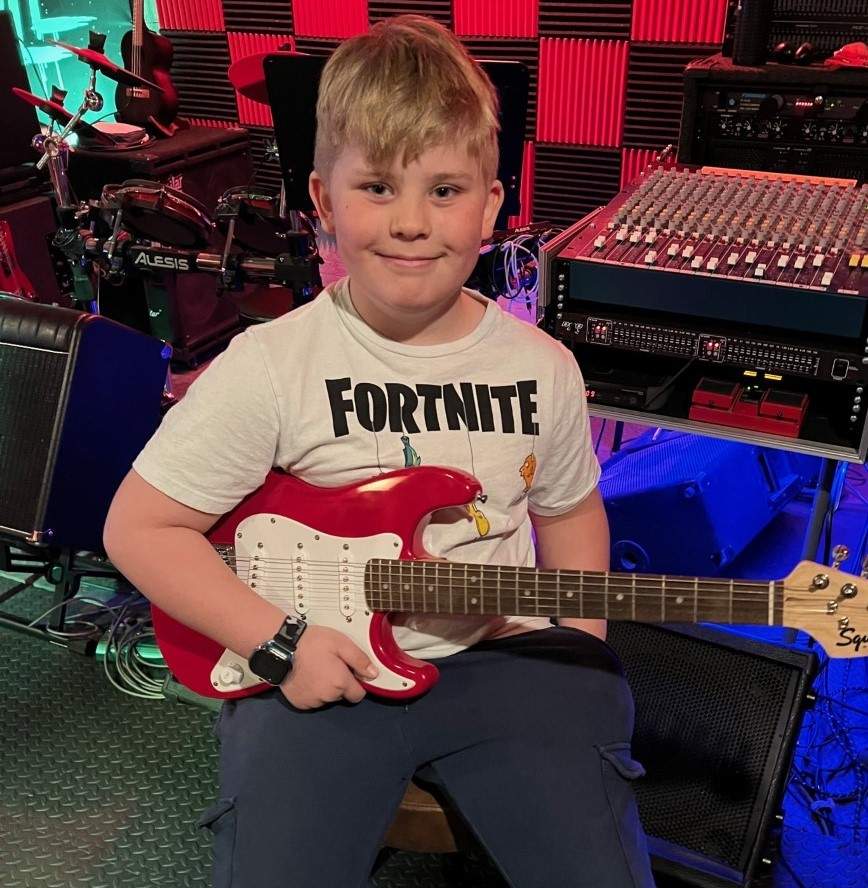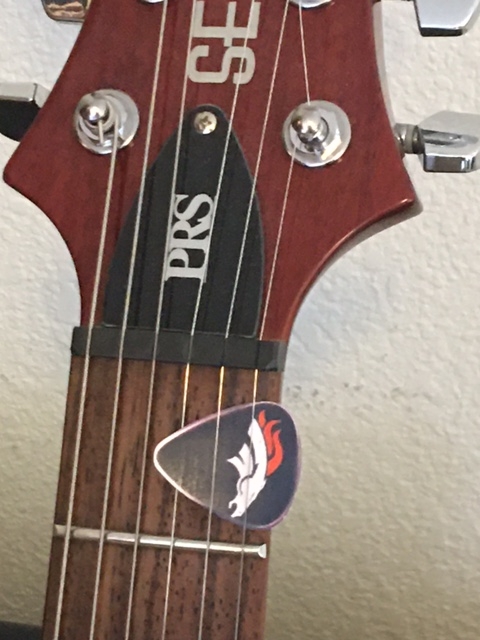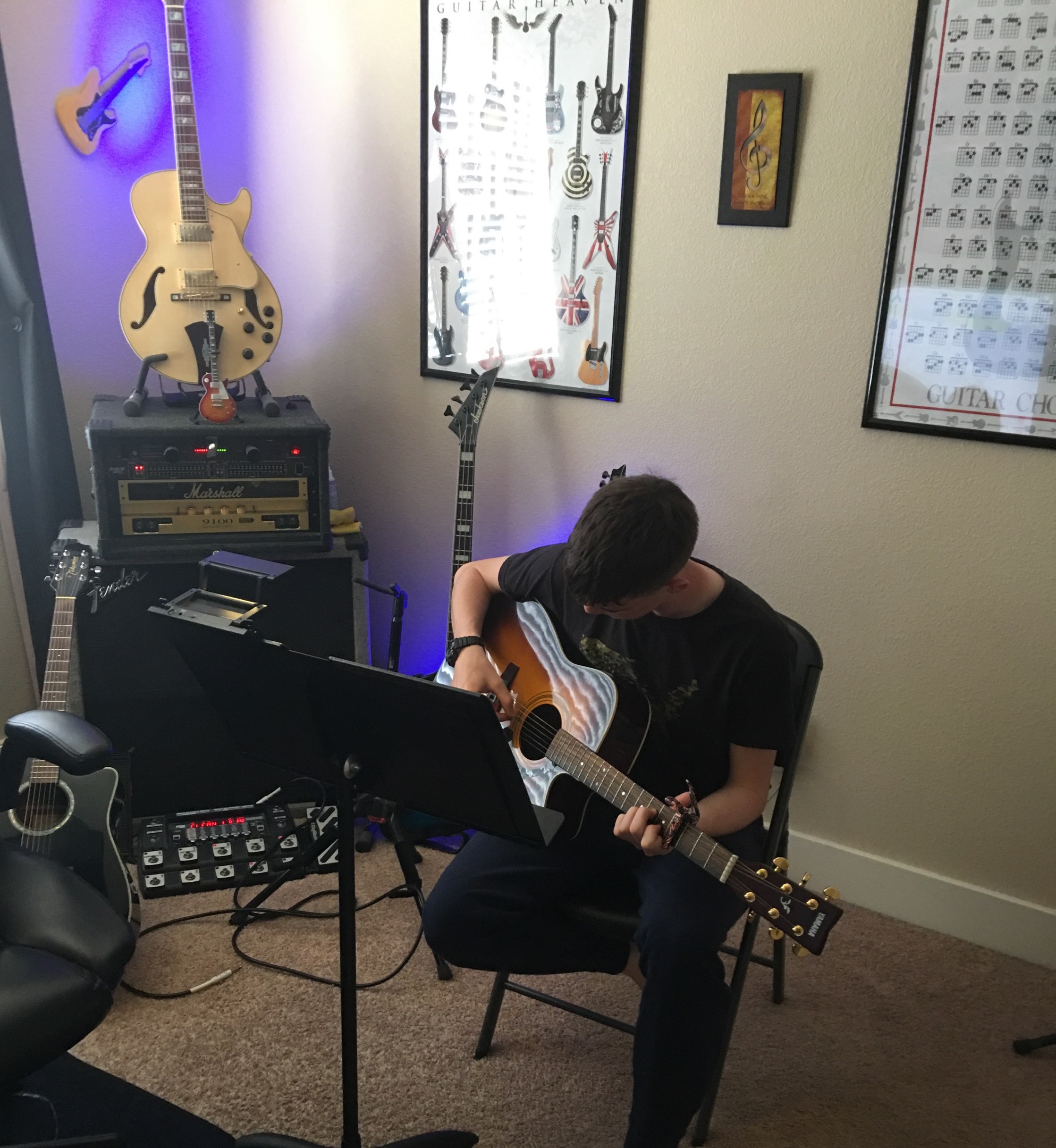Buying Your First Guitar Part 1
/in Guitar News/by KarneyThree Main Guitar Categories
Buying your first guitar can be an exciting and daunting task at the same time. There are so many choices, options, styles, and types to choose from. It is always a lot of fun helping my students pick out their first instrument, something they will have for a long time.
The very first step in buying a new guitar is to find out what type you want. The three main guitar categories are electric, classical, and acoustic. Some acoustic and classical guitars can be plugged into an amplifier, but I will look at the guitars without that option. Then we will weigh out the advantages and disadvantages.
Should Your First Guitar Be an Acoustic
 Arguably, the most popular guitar people purchase for their first guitar is an acoustic. These generally have steel strings and a large body that uses the vibration of the string through the wood to create the sound.
Arguably, the most popular guitar people purchase for their first guitar is an acoustic. These generally have steel strings and a large body that uses the vibration of the string through the wood to create the sound.
Advantages
The advantage of the acoustic is that all you need is the guitar to play. This can save a person some money since it does not require an amp, cables, etc. An acoustic guitar can be ready to play in a classroom or at a campfire in no time. They are so nice to sing with since the warm tones work very well with vocals. Acoustic guitars also tend to sound better as they age. Personally, I prefer the acoustic sound to an electric clean sound, but there are limitations as well.
Disadvantages
The disadvantage of an acoustic guitar is that it is probably the hardest guitar to learn on. Generally, the strings are much tougher to push down than the electric or classical guitar since they are thicker. This can stop young players from continuing to play because it can hurt their fingertips. Acoustic guitars are also much larger in size than both classical and electrics. If you get a cheaper one, it can make playing the guitar miserable because they are harder to play. This can lead to a beginner feeling like they do not have the skills to play.
Finally, an acoustic guitar is built for the sound produced by the types of woods and finishes they use. If you try to use overdrive with an acoustic/electric guitar, chances are it will squeal very loudly.
Thinking on Buying a Classical Guitar for Your First Guitar?
The first guitar I ever played was a classical. Classical guitars have nylon strings which produce a much warmer sound than the acoustic. The guitar has a very distinct shape and used a lot in flamenco and classical music.
Advantages
The advantage of the classical guitar is that the strings are easier to play on. The nylon strings are softer than the steel strings which will not hurt as much. The bottom strings are nylon wrapped in steel which are a bit more comfortable since they have less tension.
Classical guitars are generally a little smaller than the typical acoustic. This can help tremendously with an early teen who is too big for a ¾ size but too small for a full-size acoustic guitar. One more advantage is that the tuners are all facing toward the back which means they turn the same direction when increasing or decreasing pitch. Acoustic guitar tuners reverse directions depending on the string.
Disadvantages
The disadvantage of a classical guitar is that the wide neck makes them difficult to play. The distance the fingers must travel is much further and can make it hard to reach if you have small hands. If you are playing rock or country, the positions used on a classical guitar can make that harder as well. For instance, using the thumb over the top of the neck to create a chord is much more difficult and not intended to be done on a classical guitar.
Buying Your First Electric Guitar
 Probable the best way to go, in my opinion, is to start out with an electric guitar. They are incredibly versatile and easy to learn on. My first time plugging into an amp was amazing. I see the same excitement in a lot of my students that I had when they first try the studio amp. The electric guitar really comes to life when we engage the overdrive channel. There is something hypnotizing about the sound the strings make when the gain is turned up.
Probable the best way to go, in my opinion, is to start out with an electric guitar. They are incredibly versatile and easy to learn on. My first time plugging into an amp was amazing. I see the same excitement in a lot of my students that I had when they first try the studio amp. The electric guitar really comes to life when we engage the overdrive channel. There is something hypnotizing about the sound the strings make when the gain is turned up.
Advantages
The advantage of an electric guitar is that the strings are a lot lighter and easier to push down than both the acoustic and classical guitars. One of the biggest reasons young people stop playing is because the strings hurt their fingers. If the student cannot produce a note that does not thump or buzz, they tend to get discouraged. When that happens they stop practicing, and before you know it, they stop altogether. Another advantage to an electric guitar is that there are endless sounds it can produce. With today’s technology, electric guitars can create the sound of similar to almost any instrument. Plus, with a small battery powered amplifier, it can even go with you camping.
Disadvantages
The disadvantage of starting with an electric guitar is that it can be more expensive. You will need an amplifier and cables to be able to hear it properly. The amplifiers can run anywhere from $15 for a used starter to as much as you would like to spend. For a decent amp, you would not want to go under $100 though. It is well worth the investment to get something with at least a clean channel and a dirty channel. Effects can be optional, but these days it is very affordable to get an amp with effects.
What type of guitar is best really depends on your personal taste, but for younger students, my vote would be to get them an electric.
If you would like to take lessons and need some more information, please shoot me a message.
Should I Use a Pick?
/in Guitar News/by KarneyFingers or a Pick?
One of the questions I get asked the most as a guitar instructor is “should I use a pick?”
For someone who is just starting out, I would recommend trying one. It is also important to use your fingers to strum or pluck a melody as well. As you become more comfortable, try using a pick at the same time as plucking with your fingers…this is known as hybrid picking.
Sometimes it is more difficult to start with a pick since plucking with the thumb can feel natural and much easier. However, I would give it a few months to get used to. You may find that you will need both to really be a versatile player.

Versatility
The short of it is that there are things that are very difficult to do without a pick like pinch harmonics and sweep picking. There are also things that are much easier to do using your fingers instead such as arpeggios, double stops and even some solos.
Tone and Dynamics
Tone is usually completely different using a pick verses your finger. The thickness of a pick will make a huge difference in tone and playing speed. Try using multiple thicknesses when experimenting. The thin picks will take more time to snap back into place after plucking a string so it may be slower than a thicker one when soloing. Additionally, you may also be able to get more volume.
Dynamics can be easier as well with the fingers due to tactile feedback. The ability to use the fingernail and the fleshy part of the skin will provide more variety and color.
Advantages of Finger-style
Another reason you will want to become proficient at using your fingers is that at some point you will inevitably drop your pick while playing. If you’re in front of other people, you will need to continue on without one. This is a great time to be able to switch to finger-style.
Sometimes it just makes more sense to solo without a pick. The lead at the end of Dire Straits “Sultans of Swing” is actually much easier to play finger-style.
Advantages of Using a Pick
The advantage of using a pick is that you can do those cool tricks like fast tapping. Specifically, the solo in Ozzy Osbourne’s “Crazy Train” taps with a pick at the 3 minute mark. Also, pinch harmonics, sweep picking, palm muting, and fast single string passages are much easier with a pick. Some of these tricks can be done without, but it is more difficult for new guitarists.
If you are interested in lesson, please contact me. I teach online as well as in person.
What to Expect at Your First Guitar Lesson
/in Guitar News/by KarneyThe First 10 Minutes
 A lot of people have no idea of what to expect when going into their first guitar lesson. Most people are very nervous and usually have never touched a guitar before. For many students, they have never played an instrument before either.
A lot of people have no idea of what to expect when going into their first guitar lesson. Most people are very nervous and usually have never touched a guitar before. For many students, they have never played an instrument before either.
The very first thing I like to do is find out what the student is interested in musically. This includes asking about their goals and what inspired them to pick up the guitar. It is also very important to know what style of music they enjoy. Almost everyone would rather play their favorite song than mine-although I have great taste in music 😊!
After finding out about their goals, the next step is to see what type of experience they have in music and on the guitar. For this post, I will focus on what the new students will learn on the first day.
Hands On
If you are brand new, then I like to take a couple of minutes to go through the guitar and explain how it works. This includes what all of the knobs are for, what the frets are, how to use the tuning pegs, the names of the strings, etc. Then I demonstrate how to hold the guitar and why the hand position is a certain way for different styles.
Once the student is comfortable with the hand position on the guitar, the next step is tuning. This is sometimes tough for the younger kids, so I have them try a single string and I tune the rest for them. It is really fun to watch how each week they improve on their tuning skills. In just a few lessons, they are experts!
Finally, we learn how tablature works and they play a simple melody on the first day. This is where each student realizes how incredibly easy guitar is to learn. It is fun to see them light up after that part of the lesson, and they are ready to pursue music.
Why I Teach
The part I like the most is when a new student wants to try a lesson to see if they even like it and end up becoming totally inspired. The parents immediately pick up on it…that is so rewarding! My goal is to keep learning along with the student. There are always new songs and new ideas to try.
If you have any questions or would like to try a lesson, feel free to contact me. I teach at Boomer Music in Fort Collins, as well as out of my studio here in Greeley.
Advantages of Playing a Musical Instrument
/in Guitar News/by Karney Advantage of Playing a Musical Instrument
Advantage of Playing a Musical Instrument
Most people have heard of some of the advantages to playing a musical instrument. But did you know it is one of the few activities that works the entire brain? Recently, scientists have studied the brain using FMRI and PET scans and observed the brain lighting up when listening to music. Once they gave the person an instrument to play, the brain went into overdrive. The main areas were in the visual, motor, and auditory cortex, however almost every area of the brain was active.
Areas Improved by Playing:
- Fine motor skills-which are affected on both sides of the brain
- Mathematical and creative areas of the brain
- The size of the corpus callosum
- Volume of transmissions in the corpus callosum (which helps with creative problem solving)
- Higher brain executive functions which control planning, strategizing, and attention to detail
- Emotional and mental qualities
- Enhanced memory functions
- Abstract reasoning skills
- Eye-hand coordination
- Verbal IQ skills
- Study habits
- Self-esteem-especially in people with dyslexia because of the increased ability to focus
- The ability to focus for longer periods
- Ability to give and receive constructive criticism
- Working with other people in groups
- Attentiveness
Areas improved at the school level as a result of playing a musical instrument are:
- Higher scores on spelling tests
- Better attendance rates because students look forward to the music programs
- Students score higher on standardized tests
- Students learn a lot about the rewards of hard work since they have to work hard to play well
Scientists have also compared studying music to other art forms. When they did, it was discovered that learning a musical instrument was unique in its benefits. If you are interested in more reading with proven statistical information, Sharon Bryant wrote a great article on this. She has sited numerous studies and have shown how school children have benefited academically through their music programs.
Please contact me if you would like to learn to play the guitar, bass, or ukulele.
Ideas to Help Inspire Guitar Practice
/in Guitar News/by Karney
“We are what we repeatedly do. Excellence, then, is not an act, but a habit.” -Aristotle
Here is a summary of Justin Colletti’s Building the Practice Habit
which has some great ideas to help inspire guitar practice.
- Make a commitment in writing of what your goal is during guitar practice.
- Studies have shown that by writing down your goals and plans, you will have a greater chance of following through on them.
- Be realistic about guitar practice.
- By putting an unsustainable routine together, practice becomes a punishment rather than something to look forward to. Mr. Colletti uses a perfect analogy of how workout facilities in January are full of new people trying to get into shape, but after a few weeks, people give it up. This is usually due to taking on too much in the beginning.
- Make a list of things that might stop you from practicing the guitar.
- What things will prevent you from sticking to a routine? Does checking email or Facebook prior to starting your practice prevent you from following through? Try to reschedule those events to a time where they will not interrupt your practice schedule. By limiting certain triggers, more focus can be placed on the practicing itself.
- Treat Yourself.
- One way to break a bad habit is to keep the reward but use it as a motivator for practicing. One example may be to have a cup of coffee while practicing instead of reading a newspaper or watching a video.
- Social Accountability.
- Studies have shown that by committing publicly what you plan to do can be a huge motivator. This can increase follow-through dramatically, even more than writing down a goal. You may want to let your friends on Facebook know that you have picked up the guitar and are learning how to play.
- Keep track of your success.
- Watching your progress and keeping track of your success in a journal or Excel can really reinforce your commitment.
If you would like to try a guitar lessons, please contact me.
The Good and Bad of Online Guitar Lessons
/in Guitar News/by Karney The Good and Bad of Online Guitar Lessons
The Good and Bad of Online Guitar Lessons
If you can’t meet a teacher in person, online lessons are a great alternative. It may never replace the in-person experience, but it is useful, especially for people with limited time.
The Good
- Lessons are available from anywhere in the world as long as there is a reliable internet connection.
- There are a wider range of teachers to choose from.
- It is nice to be able to stay in the comfort of your own home.
- There can be more flexibility in scheduling, especially if the instructor only teaches online.
- The ability to avoid the frustration of commuting, especially in busy cities where there is a lot of traffic congestion.
The Bad
- It is difficult to play music together since there is usually a delay in audio and video.
- Missing out on personal interaction can really make a difference. The one on one lessons can create a warmer atmosphere.
- Without a good internet connection, the experience can be dismal at best. The dropped connections and stuttering can become too distracting with a slow internet.
- Laptop speakers dramatically decrease the quality of sound compared to in person lessons.
- For younger students who use devices with small screens, it is hard to see what the instructor is doing.
My Favorite Platform
I use several platforms to teach guitar lessons online, they all have pluses and minuses, but Zoom is my favorite. This program has a lot of versatility, but probably the best thing about it is the screen share. On one screen, the instructor can be visible while displaying the music on another. Zoom is packed with tools that help tremendously while teaching. There is also a whiteboard which can be used by both the student and the instructor. Once complete, the student can save all the information into their file. This is incredibly convenient!
Feel free to contact me if you have any questions about taking guitar lessons online or in person.
Online Guitar Instructor or YouTube
/in Guitar News/by KarneyShould I have an Online Guitar Instructor or YouTube It?
With so many videos on YouTube, why should a person pay for an online guitar instructor instead of using YouTube? After taking and teaching lessons my entire adult career, I believe it is important to have someone who can watch and assist you while playing. This can be both in person or online.
I have had the privilege of working with many self taught guitarists who have had to unlearn habits making certain songs hard to play. So I want to pass along several reasons to have a live instructor assist in learning any instrument. Here is a list of 5 reasons it helps to have a guitar instructor.
Increase Your Musical Understanding
It is such a good feeling to learn a song and be able to play it for friends and family. But having a background on how things work together really gives a person a whole new musical perspective. Learning how things fit together and why is important when taking the next step on any instrument. If you ever want to write a song or make your solo a little tastier, having a few tools can make all the difference in the world. An instructor can tell you why a song used a certain set of notes, or show you how a small tweak can make a solo come to life. One example is to move a rock scale (pentatonic minor) up a four frets and all of a sudden you have an amazing jazz scale.
Adding Helpful Playing Hints
Something so small such as a certain fingering can preventing you from playing a song smoothly or even at all. This can be reason enough to sign up for online lessons. Relearning chords and solos is much harder the second time around because it is so easy to fall back to what we are used to.
Playing without correct form can also put a lot of strain on your wrist leading to tendinitis or carpal tunnel syndrome. An instructor can recommend a simple adjustment of the guitar neck or your hand position which may be all you need to remedy this.
Stylistic differences can be important as well. If you are learning blues, your hand position is often much different than a classical guitarist’s hand position. The reasons are clear from a guitar instructor’s point of view, but maybe not to a beginner. Knowing what to look for can save a lot of anguish in the long run.
Advice For Your Band Situation
 If this is a direction you want to go, then having a guitar instructor who has been there is extremely important. This is one area that can save you considerable time hunting through videos. Sometimes articles play up one area or another in order to keep their audience entertained, but having someone to ask the questions to is invaluable.
If this is a direction you want to go, then having a guitar instructor who has been there is extremely important. This is one area that can save you considerable time hunting through videos. Sometimes articles play up one area or another in order to keep their audience entertained, but having someone to ask the questions to is invaluable.
If you are with someone who has toured, they will volunteer ideas and information you may have never thought to ask. Even simple things like how to run your guitar cable can make a big difference on a crazy night on stage.
Staying on Schedule
Probably the biggest reason people stop learning anything is because they do not stay with it. YouTube could be a great resource if you are very motivated and dedicated, but knowing you are accountable to a preset time with an instructor can keep you on a regular schedule. There are many adult students who only have time to play their instrument during that half hour or hour lesson and that can be enough to keep propelling them forward. Otherwise, other life events may take over.
Online Instructors Will Keeping You Motivated
The biggest reason to have an instructor is to help you stay motivated. An instructor can pass along songs that they know students really enjoy playing. Sometimes this is all it takes to get back into the excitement of music. Having a song or solo etc. can really make a person want to sit down and take the time to practice. Practicing is tedious without a goal or inspiration to help us along.
All and all, a live instructor is a great way to save countless hours hunting for the right video and hoping the teacher really knows what they are talking about. If you ever have any questions, let me know. I will be happy to help you start, or continue on, your musical path.
I am excited to announce that I am now offering online lessons! If you or the kids would like to pick up a new skill, I would be very interested in the opportunity to help!
Jam Sessions
/in Guitar News/by KarneyRocking the Jam sessions!
Jam sessions are one of the events the students really look forward to. There are generally five to seven students for each jam session. They will all perform one song that they worked on in the private lessons. The older students will also solo over a blues progression if they would like to. It is a lot of fun to improvise over a 12 bar blues with other musicians.
Scott, Ralph, Colin, and Cooper will be rocking out some oldies for the next session. Anyone who is interested has an open invitation to get together in a band situation with other students. It is a lot of fun and there is absolutely no pressure.
How Do the Jam Sessions Work?
 The sessions are slated for Sundays between 2pm and 4pm. Each student is asked what song they would like to play. Those songs are put on a list and each person picks from those. Sometimes, if the songs have parts that are too difficult for any instrument, we remove those or simplify them if possible. We currently only perform one song in order to keep the sessions at a comfortable length.
The sessions are slated for Sundays between 2pm and 4pm. Each student is asked what song they would like to play. Those songs are put on a list and each person picks from those. Sometimes, if the songs have parts that are too difficult for any instrument, we remove those or simplify them if possible. We currently only perform one song in order to keep the sessions at a comfortable length.
After that, we take about a month or two to work on the songs in the private lessons and get them ready for the next jam session.
When the day arrives, the students meet at the studio with their instrument(s). All the cables, amps, microphones, drums, and sound reinforcement are provided. The parents, siblings, wives, husbands, friends etc. are all encouraged to attend. Students are welcome to bring snacks or drinks. We then run through the songs three to four times; once with the music, once without, then again to work out the little bugs. After that, the song is performed a final time so the parents can take pictures with the light show or record the performance on video.
If you are interested in taking lessons and be a part of the optional jam sessions, please contact me for more information.

